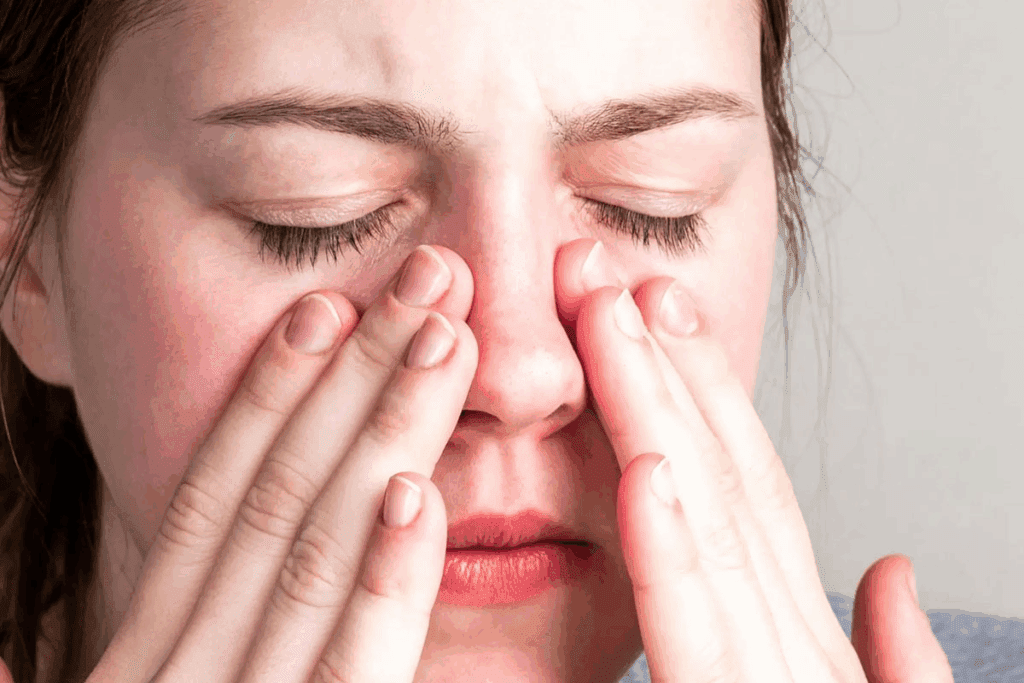Last Updated on November 27, 2025 by Ugurkan Demir

Seeing yellow fluid draining from your nose can be scary. But knowing what it means is the first step to feeling better. At Liv Hospital, we know that yellow watery nasal discharge is your body’s way of fighting off germs or reacting to things in the air. How to treat yellow fluid from nose and when to seek immediate medical advice, especially if the discharge is profuse or salty.
We focus on you at Liv Hospital. We use the latest tools and care with kindness to find out why your nose leaking yellow fluid. Then, we create a treatment plan just for you. We’ll help you understand your diagnosis and the options for treatment.

When your nasal discharge turns yellow, it’s normal to worry. Nasal discharge, or mucus, is key to our respiratory health. Its color can show if there’s an issue.
Our bodies make about 1.5 liters of mucus every day. It catches dust, bacteria, and other harmful stuff, protecting our lungs. Usually, it’s clear and thin, but it can change color or thickness if we’re sick or allergic.
Mucus is made up of water, mucins, and other stuff. These help keep our airways safe.
Yellow nasal discharge comes from white blood cells. These cells fight infections by releasing enzymes that turn mucus yellow.
“The presence of yellow nasal discharge often indicates that the body is responding to an infection or inflammation in the nasal passages or sinuses.”
This color change might mean you have a cold, allergies, or something else. You might also feel stuffy, have sinus pressure, or a sore throat.
How long yellow nasal discharge lasts depends on the cause. If it’s from a cold, it might stick around for a week or two.
Cause | Typical Duration |
Viral Infection (Common Cold) | 7-14 days |
Bacterial Sinus Infection | More than 14 days, potentially requiring antibiotic treatment |
Allergic Rhinitis | Varies, often persistent if allergen exposure continues |
Knowing why your nasal discharge is yellow is key. It helps figure out the right treatment and when to see a doctor.

Yellow nasal discharge can signal several health issues, from infections to allergies. It’s important to know the causes to manage it effectively.
We’ll look at the main reasons for yellow nasal discharge. This includes infections and allergic reactions. It will help you understand your symptoms better.
Viral infections, like the common cold and flu, often cause yellow nasal discharge. These infections make the nasal passages inflamed and produce more mucus. This mucus can turn yellow because of white blood cells.
The body fights these viruses by sending white blood cells. This fight results in the yellow color of the nasal discharge.
Bacterial sinus infections, or sinusitis, also lead to yellow nasal discharge. These infections make the discharge thick and yellow or green. They often start after a viral infection.
These infections are more serious and might need antibiotics to treat.
Allergic rhinitis, or hay fever, is an allergic reaction to things like pollen or pet dander. It can cause nasal discharge that’s clear or yellow, depending on if there’s an infection.
If allergic rhinitis gets a secondary infection, the discharge can turn yellow. It’s key to manage allergies to avoid this.
Chronic sinusitis is when the sinuses are inflamed or infected for over 12 weeks. It can cause yellow nasal discharge and other symptoms.
It can be caused by allergies, anatomical issues, or immune system problems. Treating it often involves medicine and sometimes surgery.
Figuring out why you have yellow fluid from your nose involves several steps. It’s important to find the cause to treat it right and feel better.
It’s hard to tell if your yellow nasal discharge is from a virus or bacteria. Viral infections usually come with a sore throat, cough, and body aches. On the other hand, bacterial infections can cause a high fever and thick, yellow nasal discharge.
Doctors will do a physical examination and look at your medical history. They might also do a nasal swab to check for bacteria.
Allergies can also cause yellow nasal discharge. Allergy testing can find out what’s causing your symptoms. This might include skin prick tests or blood tests.
After finding the allergen, you can avoid it. Sometimes, immunotherapy is suggested to help you get used to the allergen.
If you’re not getting better or if the cause is unclear, imaging studies like CT scans might be needed. These can show if there are any problems like sinusitis.
A CT scan gives detailed pictures of your nasal passages and sinuses. This helps doctors understand the problem better and decide on the right treatment.
OTC treatments offer many solutions for yellow nasal discharge. They help ease symptoms and find the cause. We’ll look at decongestants, antihistamines, pain relievers, and nasal sprays.
Decongestants help with nasal congestion from yellow discharge. They reduce swelling, making breathing easier. There are oral and nasal spray types.
Oral decongestants, like pseudoephedrine, come in tablets or capsules. They work well but might cause side effects like insomnia. Nasal sprays, with oxymetazoline or phenylephrine, offer quick relief but use them carefully to avoid congestion.
Type | Examples | Usage |
Oral Decongestants | Pseudoephedrine | Tablet or capsule form |
Nasal Sprays | Oxymetazoline, Phenylephrine | Sprayed directly into the nostrils |
Antihistamines help with yellow nasal discharge from allergies. They block histamine, reducing allergy symptoms. OTC options include diphenhydramine and loratadine.
“Antihistamines can significantly reduce nasal discharge and other allergy symptoms, improving quality of life for individuals with allergic rhinitis.” – Medical Expert, Allergist
Pain relievers like acetaminophen or ibuprofen help with headaches and facial pain. They reduce inflammation and block pain signals.
It’s important to follow dosage instructions to avoid side effects like stomach issues or liver damage.
Nasal sprays are a common OTC choice for yellow nasal discharge. Saline sprays moisturize the nose, thinning mucus. Steroid sprays, like fluticasone, reduce inflammation and manage chronic discharge.
When using OTC treatments, always read and follow the label. If symptoms don’t improve or get worse, see a healthcare professional.
For yellow nasal discharge that won’t go away, there are prescription treatments. If home remedies don’t work, doctors might give stronger meds. These help find and fix the cause of the yellow fluid.
Antibiotics are for bacterial infections causing yellow nasal discharge. Bacterial sinus infections often need these meds. It’s important to use them right to prevent resistance.
Prescription-strength decongestants help with severe nasal congestion and yellow discharge. They’re used for a short time because of possible side effects.
Corticosteroid nasal sprays reduce inflammation in the nose. They’re good for long-term issues like allergies.
For long-term yellow nasal discharge from allergies, immunotherapy might help. It involves regular shots or tablets to build up a tolerance to allergens.
It offers lasting relief by tackling the allergy root cause.
Knowing about these prescription meds helps those with yellow nasal fluid. They can work with their doctor to find the right treatment.
Seeing yellow watery nasal discharge can be scary, but there are ways to handle it at home. These methods can ease your discomfort and help find the cause of the discharge.
Saline nasal irrigation is a simple yet effective way to clear your nasal passages. It uses a saline solution to moisturize and help drainage.
To do saline nasal irrigation, you can use a neti pot or a squeeze bottle. Mix 1/4 teaspoon of salt and 1/2 teaspoon of baking soda in 8 ounces of warm water. Stir until the salt is dissolved, then gently irrigate your nasal passages.
Steam inhalation is another good home remedy for yellow watery nasal discharge. It helps loosen mucus, reduces congestion, and promotes sinus drainage.
You can inhale steam by filling a bowl with hot water and leaning over it with a towel. Or, you can use a steam humidifier in your home to keep the air moist.
Certain essential oils have natural decongestant and anti-inflammatory properties. Eucalyptus oil, peppermint oil, and tea tree oil are good for relieving nasal congestion.
To use essential oils, add a few drops to a diffuser or mix with a carrier oil for topical use. Always dilute essential oils with a carrier oil before applying to your skin, as they can be strong.
Drinking plenty of fluids and getting enough rest are key to managing yellow watery nasal discharge. Fluids help thin out mucus, making it easier to expel. Rest helps your body fight off the infection.
Remedy | Benefits | Tips |
Saline Nasal Irrigation | Moisturizes nasal mucosa, promotes drainage | Use a neti pot or squeeze bottle, mix saline solution correctly |
Steam Inhalation | Loosens mucus, reduces congestion | Use a bowl of hot water or a steam humidifier |
Essential Oils | Natural decongestant and anti-inflammatory properties | Dilute with carrier oil, use in diffuser |
Hydration and Rest | Thins out mucus, supports immune response | Drink plenty of fluids, get adequate sleep |
By adding these home remedies to your daily routine, you can manage yellow watery nasal discharge and improve your nasal health.
Nasal irrigation is a simple way to handle yellow fluid discharge from the nose. It helps clear out your nasal passages. This can reduce congestion and ease symptoms like bright yellow fluid coming out of nose.
We will show you how to do nasal irrigation. You’ll learn about the equipment you need, how to make saline solution, the right technique, and how to keep your device clean.
First, pick the right device for nasal irrigation. You can choose from neti pots, squeeze bottles, or bulb syringes. Look for something easy to use, made from BPA-free materials, and easy to clean.
“The key to successful nasal irrigation is using the right equipment and technique,” say healthcare experts.
You’ll need a saline solution for nasal irrigation. You can buy pre-made packets or make your own. To make it safely, mix 1/4 teaspoon of non-iodized salt and 1/2 teaspoon of baking soda in 8 ounces of warm water.
Make sure the water is either sterile or boiled and cooled. “Using sterile or properly treated water is key to avoid infection,” experts warn.
To irrigate your nasal passages:
Be gentle and don’t force the solution. This can cause discomfort or injury.
After each use, rinse your device with sterile or distilled water. Let it air dry. Regular cleaning and drying prevent bacterial growth and ensure safe use.
By following these steps and keeping your equipment clean, nasal irrigation can help manage yellow fluid in nose. It can also improve your nasal health.
To stop yellow nose drainage from coming back, we need to tackle many factors. We should control allergens, boost our immune system, manage humidity and air, and get ready for the seasons. These steps can help a lot in reducing yellow fluid from the nose.
One important step is to limit our exposure to allergens. Here’s how:
By avoiding allergens, we can lower the chance of yellow fluid from the nose.
A strong immune system helps fight off infections that cause yellow liquid from the nose. Here are ways to support it:
Boosting our immune system helps us fight off infections that lead to yellow nasal discharge.
It’s important to manage humidity and air quality to prevent yellow fluid from the nose. Here’s how:
By controlling humidity and air quality, we can lower the risk of yellow nasal discharge.
Getting ready for the seasons can help prevent yellow nose drainage. Here are some tips:
Being proactive helps us deal with seasonal allergens and keep our noses healthy.
Prevention Strategy | Description | Benefit |
Allergen Control | Using allergen-proof bedding, removing carpets, keeping windows closed | Reduces exposure to allergens |
Immune System Support | Balanced diet, regular exercise, adequate sleep, supplements | Boosts immune function |
Humidity and Air Quality Management | Using humidifiers/dehumidifiers, avoiding irritants, ensuring ventilation | Prevents nasal irritation |
Seasonal Preparation | Monitoring pollen counts, stocking medications, maintaining a clean home | Minimizes seasonal allergy impact |
Seeing bright yellow fluid from your nose can be scary. It’s important to know when to see a doctor. Some yellow nasal discharge might go away by itself. But, others need medical help to avoid problems or find the cause.
Some symptoms with bright yellow nasal discharge need quick doctor visits. These include:
Other symptoms with bright yellow nasal discharge also need doctor visits. These include:
If your bright yellow nasal discharge keeps coming back or gets worse, see a doctor. It might mean the problem isn’t being treated right.
Children and older people might get sicker from nasal discharge because their immune systems are weaker. They should watch their symptoms closely and see a doctor if:
In summary, while some bright yellow nasal discharge might go away, knowing when to see a doctor is key. This helps avoid serious problems and get the right treatment.
It’s important to know why you have yellow watery nasal discharge. This can happen for many reasons, like viral infections, bacterial sinus infections, or allergies.
Once you find out why, you can start treating it. You might need decongestants, antihistamines, or antibiotics. Home remedies like saline nasal sprays and steam inhalation can also help.
To stop yellow fluid from coming back, you need to take care of your environment and your body. This means controlling allergens, boosting your immune system, and keeping the air moist. These steps can help lessen how often and how bad the yellow fluid is.
Handling yellow nasal discharge well means tackling the root cause and using the right treatments. It also means taking steps to prevent it from happening again. This way, you can feel better and live a happier life.
Yellow fluid in your nose can come from infections, allergies, or sinusitis. This color change happens because white blood cells are fighting off the infection.
Not always. It might mean you have an infection or allergy. But, it’s often a temporary issue that can be treated. If you have other bad symptoms, you should see a doctor.
Viral infections usually cause clear or white discharge. Bacterial infections might make it yellow or green. But, only a doctor can really tell you what it is.
Allergies can make your nose run, but it’s usually clear. If you have allergies and then get a secondary infection, the discharge might turn yellow or green.
How long it lasts depends on the cause. With the right treatment, it can go away in a few days to a week. If it doesn’t, you should see a doctor.
You can buy decongestants, antihistamines, pain relievers, and nasal sprays without a prescription. Always follow the instructions and talk to a doctor if you’re not sure.
You’ll need antibiotics if the discharge is from a bacterial infection. A doctor will decide if you need them based on what they find.
Yes, using a saline solution in a nasal spray can help. Just make sure to use clean water and follow the right steps to avoid problems.
To stop yellow discharge from coming back, try to control allergens, boost your immune system, and manage humidity and air quality. Also, be ready for seasonal changes.
See a doctor if your symptoms are severe, the discharge doesn’t go away with treatment, or if you’re at high risk, like being young or old. Also, watch out for signs like a lot of facial pain or a high fever.
Some essential oils, like eucalyptus or peppermint, might help with congestion. But, use them carefully and talk to a doctor first, even more so if you have health issues.
Clear yellowish liquid can mean you have an infection or allergy. It’s not always a big deal, but watch it and see a doctor if it doesn’t get better or if you have other bad symptoms.
People often use these terms the same way, but “yellow fluid running from the nose” usually means thicker discharge. Both can mean you have a problem, and doctors treat them the same way.
Yes, sinusitis, like bacterial sinusitis, can make your nose drain yellow or green. If you have bad symptoms, you should get checked by a doctor.
To handle yellow watery nasal discharge at home, try saline nasal irrigation, steam inhalation, drink lots of water, and rest. You can also use over-the-counter meds to help.
Subscribe to our e-newsletter to stay informed about the latest innovations in the world of health and exclusive offers!